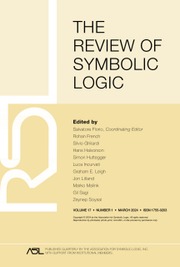Crossref Citations
This article has been cited by the following publications. This list is generated based on data provided by Crossref.
Read, Stephen
2015.
Paradox, Closure and Indirect Speech Reports.
Logica Universalis,
Vol. 9,
Issue. 2,
p.
237.
Read, Stephen
2019.
Graham Priest on Dialetheism and Paraconsistency.
Vol. 18,
Issue. ,
p.
439.
Bacon, Andrew
and
Goodman, Jeremy
2022.
Against Disquotation.
Australasian Journal of Philosophy,
Vol. 100,
Issue. 4,
p.
711.
Sandgren, Alexander
2025.
Swyneshed Revisited.
Ergo an Open Access Journal of Philosophy,
Vol. 12,
Issue. 0,
Masterman, Christopher J
2025.
Two distinctions about world-relative truth.
Analysis,
Vol. 85,
Issue. 2,
p.
376.

